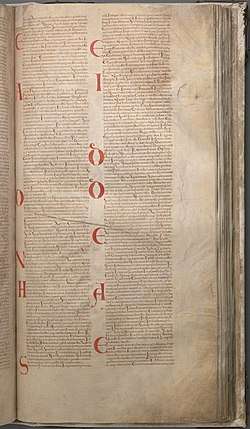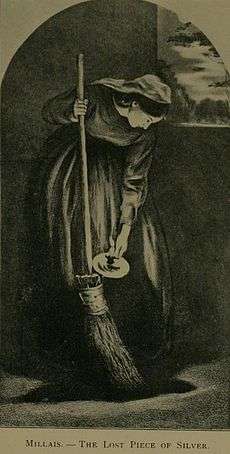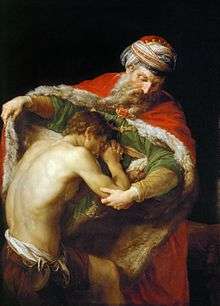Luke 15
Luke 15 is the fifteenth chapter of the Gospel of Luke in the New Testament of the Christian Bible. The book containing this chapter is anonymous, but early Christian tradition uniformly affirmed that Luke composed this Gospel as well as Acts.[1] This chapter records three parables of Jesus Christ: the lost sheep, the lost coin and the lost or 'prodigal' son.[2][3] Biblical commentator Heinrich Meyer refers to this chapter, the following chapter and Luke 17:1-10 as a "new, important, and for the most part parabolic set of discourses" linked by the murmuring of the Pharisees and Jesus' responses to them and to his disciples.[4]
| Luke 15 | |
|---|---|
 The Latin text of Luke 14:30–19:7 in Codex Gigas (13th century). | |
| Book | Gospel of Luke |
| Category | Gospel |
| Christian Bible part | New Testament |
| Order in the Christian part | 3 |
Text
The original text was written in Koine Greek. This chapter is divided into 32 verses.
Textual witnesses
Some early manuscripts containing the text of this chapter are:
- Papyrus 75 (AD 175-225)
- Codex Vaticanus (325-350)
- Codex Sinaiticus (330-360)
- Codex Bezae (~400)
- Codex Washingtonianus (~400)
- Codex Alexandrinus (400-440)
Murmuring of the Pharisees and scribes
Verse 2
- And the Pharisees and scribes complained, saying,
- "This Man receives sinners and eats with them." [5]
Meyer notes and compares the murmuring of the Pharisees and scribes (verses 1–2) with the murmurings of the Israelite community in the wilderness in Exodus 16:1-8 and 17:3.[4]
Parable of the Lost Sheep

Verses 3–7 records this parable which appears in two of the Canonical gospels of the New Testament, as well as in the non-canonical Gospel of Thomas.[6] According to the Gospels, a shepherd leaves his flock of ninety-nine sheep in order to find the one sheep who is lost. It is the first member of a trilogy about redemption that Jesus tells after the Pharisees and religious leaders accuse him of welcoming and eating with "sinners."[7] The two parables that follow (in Luke's Gospel) are those of the Lost Coin and the Prodigal Son.
Parable of the Lost Coin

This parable in verses 8–10 appears in only one of the Canonical gospels of the New Testament, namely the Gospel of Luke. It recounts a story about a woman with ten silver coins (Greek drachmae) losing one. She then lights an oil lamp and sweeps her house until she finds it, rejoicing when she does. It is a member of a trilogy on redemption that Jesus tells after the Pharisees and religious leaders accuse him of welcoming and eating with "sinners."[7]
Parable of the Prodigal Son

The Prodigal Son, also known as Two Sons, Lost Son, The Running Father and The Loving Father is one of the parables of Jesus that appears in only one of the Canonical gospels of the New Testament, namely in verses 11–32 of this chapter in the Gospel of Luke. It recounts about a father who gives the younger of his two sons his inheritance before he dies. The younger son, after wasting his fortune (the word 'prodigal' means 'wastefully extravagant'), goes hungry during a famine. He then repents and returns home with the intention of begging to be employed and renouncing his kinship to his father. Regardless, the father immediately welcomes him back as his son and holds a feast to celebrate his return. The older son refuses to participate, stating that in all the time the son has worked for the father, he did not even give him a goat to celebrate with his friends. His father reminds the older son that everything the father has is the older son's, but that they should still celebrate the return of the younger son as he has come back to them. It is the third and final part of a cycle on redemption, following the Parable of the Lost Sheep and the Parable of the Lost Coin.
In Western Catholic tradition, this parable is usually read on the fourth Sunday of Lent (in Year C),[8] while in the Eastern Orthodox Church it is read on the Sunday of the Prodigal Son.
See also
- Ministry of Jesus
- Parables of Jesus
- Related Bible parts: Matthew 18
References
- Holman Illustrated Bible Handbook. Holman Bible Publishers, Nashville, Tennessee. 2012.
- Section headings in the New International Version and New King James Version
- Halley, Henry H. Halley's Bible Handbook: an Abbreviated Bible Commentary. 23rd edition. Zondervan Publishing House. 1962.
- Meyer, H. A. W., Meyer's NT Commentary on Luke 15, accessed 29 June 2018
- Luke 15:2 NKJV
- Gospel of Thomas: 107 Lamb translation and Patterson/Meyer translation.
- Richard N. Longenecker, The Challenge of Jesus' Parables, Eerdmans, 2000, ISBN 0-8028-4638-6, pp. 201–204.
- TextWeek.com. "Lent 4C". Retrieved 2013-09-12.
External links
- Luke 15 King James Bible - Wikisource
- English Translation with Parallel Latin Vulgate
- Online Bible at GospelHall.org (ESV, KJV, Darby, American Standard Version, Bible in Basic English)
- Multiple bible versions at Bible Gateway (NKJV, NIV, NRSV etc.)
| Preceded by Luke 14 |
Chapters of the Bible Gospel of Luke |
Succeeded by Luke 16 |